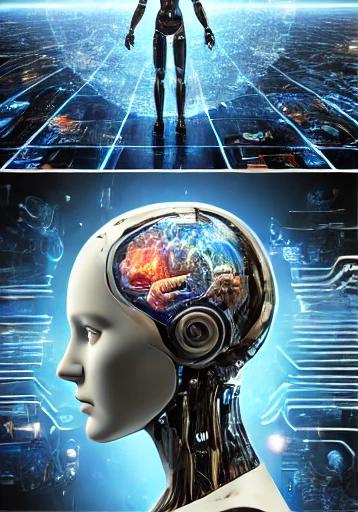Teaching Machines to Understand Us
Introduction: Bridging the Language Gap Between Humans and Machines
Have you ever asked Alexa to play your favorite song, or used Google Translate to communicate in another language? These marvels of technology are made possible by Natural Language Processing (NLP)—a fascinating branch of AI that enables machines to understand, interpret, and generate human language.
In this fourth blog of our AI Terminologies Series, we’ll explore the core concepts of NLP, how it works, and its transformative applications in everyday life.
What is Natural Language Processing (NLP)?
Definition:
NLP is a subset of Artificial Intelligence focused on enabling machines to process and analyze natural language data, such as text and speech.
Why It Matters:
Language is the primary mode of human communication. Teaching machines to understand and interact in natural language bridges the gap between humans and AI, making technology more accessible and intuitive.
Example:
When you type “best restaurants near me” into a search engine, NLP helps interpret your query and deliver relevant results.
How Does NLP Work?
NLP combines techniques from linguistics, computer science, and machine learning. Here’s a step-by-step breakdown of the process:
- Text Preprocessing:
- Cleaning and preparing raw text data for analysis.
- Techniques: Tokenization (splitting text into words or phrases), stop-word removal (removing common words like “the” or “is”), and stemming/lemmatization (reducing words to their root form).
- Feature Extraction:
- Converting text into numerical representations for machine learning models.
- Techniques: Bag-of-Words, TF-IDF (Term Frequency-Inverse Document Frequency), and word embeddings like Word2Vec or GloVe.
- Model Training and Analysis:
- Using ML algorithms to analyze patterns and relationships in the text.
- Models: Sentiment analysis models, named entity recognition (NER), and language models like GPT.
- Result Generation:
- Producing the desired output, such as a translation, summary, or sentiment score.
Key Concepts in NLP
- Tokenization:
- Splitting text into smaller units (tokens), such as words or sentences.
- Example: Breaking the sentence “I love AI” into tokens: [“I”, “love”, “AI”].
- Part-of-Speech Tagging (POS):
- Identifying the grammatical role of each word in a sentence (e.g., noun, verb, adjective).
- Example: In “The cat runs,” POS tagging identifies “cat” as a noun and “runs” as a verb.
- Named Entity Recognition (NER):
- Identifying entities like names, dates, or locations within text.
- Example: In “Elon Musk founded Tesla,” NER identifies “Elon Musk” as a person and “Tesla” as an organization.
- Sentiment Analysis:
- Determining the emotional tone of text (positive, negative, or neutral).
- Example: Analyzing customer reviews to gauge satisfaction.
- Language Models:
- Pre-trained models that understand and generate text based on patterns in data.
- Example: GPT-4, which powers tools like ChatGPT, generates human-like responses in conversations.
Applications of NLP
- Chatbots and Virtual Assistants:
- Tools like Siri, Alexa, and ChatGPT use NLP to process voice or text commands and provide intelligent responses.
- Language Translation:
- Tools like Google Translate enable seamless communication between speakers of different languages.
- Sentiment Analysis:
- Companies analyze social media posts and customer feedback to gauge public opinion.
- Text Summarization:
- NLP generates concise summaries of lengthy documents, saving time and effort.
- Example: Summarizing research papers or news articles.
- Speech Recognition:
- NLP converts spoken language into text for transcription or interaction.
- Example: Voice typing and automated captions.
- Search Engines:
- NLP helps search engines like Google understand queries and deliver accurate results.
- Content Moderation:
- Platforms like YouTube and Facebook use NLP to detect inappropriate content and enforce guidelines.
NLP Challenges
- Ambiguity:
- Human language is often ambiguous, with words having multiple meanings depending on context.
- Example: The word “bank” could mean a financial institution or the side of a river.
- Sarcasm and Idioms:
- Detecting sarcasm and understanding idiomatic expressions is difficult for machines.
- Example: The phrase “Yeah, right” could indicate agreement or sarcasm depending on tone.
- Data Quality:
- Poor-quality training data can result in inaccurate predictions or biases in NLP models.
- Language Diversity:
- Developing NLP systems for underrepresented languages and dialects remains a challenge.
Future Trends in NLP
- Multilingual Models:
- NLP systems capable of processing multiple languages with minimal training.
- Example: OpenAI’s GPT models are expanding multilingual capabilities.
- Real-Time Translation:
- Advancing speech-to-speech translation for instant cross-lingual communication.
- Emotion Detection:
- Moving beyond sentiment analysis to detect nuanced emotions like joy, frustration, or sarcasm.
- Personalized NLP Models:
- Tailored models that adapt to individual preferences and communication styles.
Conclusion: Communicating with Machines
Natural Language Processing is the bridge that connects human language and machine intelligence. By enabling machines to understand and respond to text and speech, NLP is transforming industries and making technology more intuitive.
In the next blog, we’ll explore AI Tools and Frameworks, introducing you to powerful platforms that bring AI projects to life. Stay tuned to Explore AIQ as we continue to make AI accessible, one step at a time!




